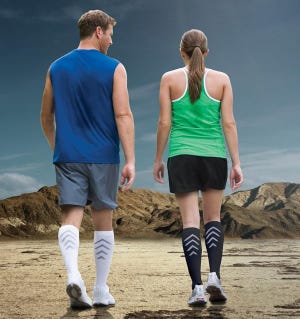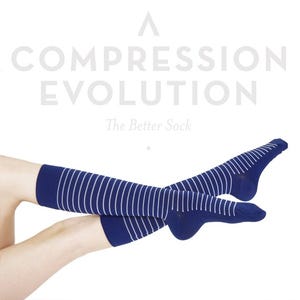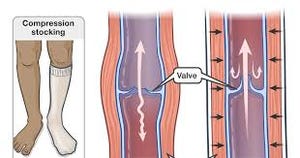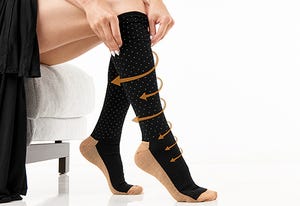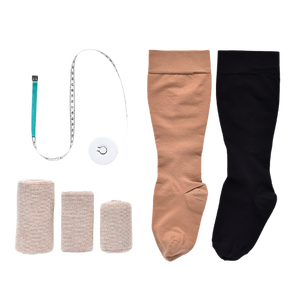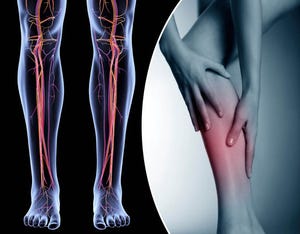Older adults make up one of the groups compression socks are recommended for as they can provide some benefit to this group. Yet like other medical interventions, compression stockings come with both benefits and risks. You have to weigh these out to see whether an intervention is more beneficial or more harmful for your particular situation. Toward that end, let’s take a look at the negatives and positives of compression stockings.
Negative Effects of Compression Stockings
Compression socks do come with some risks, yet these are generally associated with wearing them incorrectly, wearing the wrong ones or choosing ones that do not fit properly. Here is a list of negative effects of compression stockings:
Skin Issues
One of the concerns of compression socks is the negative impact they can have on the skin, especially for older adults. It’s possible for these stockings to put enough pressure to break the skin, which could lead to further problems such as sores or infection. They could also cause itchiness, redness, skin irritation or temporary skin dents. They may also cause chafing, scraping, cuts or bruises, especially when there is dryness of the skin or air.
Skin concerns from compression socks are particularly likely for certain populations, including older adults, malnourished people and people who have thin, delicate, brittle and/or easily irritated skin. Nonetheless, these negative effects to the skin are much more likely when wearing the stockings incorrectly, such as:
- Wearing the wrong size, type or compression level
- Wearing them so they create too much pressure or uneven distribution
- Overusing them
Circulation Problems
While compression stockings are designed to improve blood flow throughout the legs and body, they can do the opposite when they do not fit as they should. In this case, it’s possible for them to reduce the blood circulation in the legs.
Risks for Certain Populations
There are specific groups of people who may have risks outweigh rewards regarding compression stockings. For example, these medical garments are not recommended for people without sufficient arterial circulation or for those with severe vascular disease. Ultimately, it’s best to check with a doctor about your specific health situation before wearing them. You can also ask your doctor about the best type and compression level to wear for your case. But more people can safely wear them than not.
Positive Effects of Compression Stockings
Compression socks offer various benefits to health, especially for certain populations—such as older adults—and when worn in the correct way. Here is a list of positive effects of compression stockings:
Benefits to Blood Circulation
The reason people wear compression stockings is for their benefit to the circulatory system, which you may also hear called the vascular or cardiovascular system. Leg veins are part of this system, yet they have to work harder than veins in other areas to bring blood back to the heart, which can make them weak and not working at their best. By applying gentle pressure to the calves and ankles, compression stockings help the leg veins do their part within blood circulation.
Help with Certain Health Conditions
These socks are used in the medical system for people with health conditions or diseases that affect the circulatory system, such as venous ulcer and venous disease management or thromboembolic disease (which means a blood clot forms in the vein) prevention. Doctors often prescribe or recommend these stockings for certain medical problems or a family history of problems. Also, many people buy them over the counter for their circulatory benefits. For example, they may help to prevent varicose veins from worsening and to cut down on symptoms of varicose veins such as pain and discomfort. The benefit for certain health issues, such as preventing blood pooling and clotting, can often outweigh risks. In many cases, there can be more risk from not wearing them.
Help with Leg and Feet Swelling and Fatigue
People often choose to wear compression stockings when they experience swelling in their legs or tired legs. People who wear them for this reason tend to be those who stand all day, pregnant women and certain athletes, as well as older adults who experience these leg symptoms. Stockings or socks with a height just below the knee help prevent fluid buildup that would lead to swelling, thus helping to reduce swelling in the lower leg. Ones that go higher, up to the thigh or waist, help with blood pooling throughout the legs. Compression stockings can also help with swelling in the feet. They can be worn for feet that are aching and swelling, which may be particularly beneficial for people with diabetes.
Better Energy Levels and Wellness
Because compression stockings help blood flow better throughout the body, they can create improved energy levels. They may also help counteract certain issues like falling when you stand or feeling lightheaded. Plus, improved blood circulation helps the body carry out its daily functions, which maximizes health and wellness. Better blood flow can translate to healthier organs, less illness and better functioning of body systems. Poor blood flow can result in feeling very tired, having poor concentration and memory, slower skin healing and other negative symptoms.
What’s the Verdict on Compression Socks?
Overall, compression stockings could provide valuable health benefits, especially to certain groups of people like older adults. They offer support with blood circulation from the legs to the heart. While they do come with some risk, the risk is generally found from wearing compression stockings that do not fit or sit on the leg properly. Wearing properly fitted stockings in the correct manner provides more benefit while minimizing risk. Browse our selection of medical graduated compression socks and stockings to find the right ones for your needs at lower prices.

